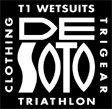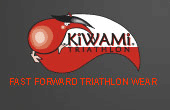TriSuit Shootout Part 3: 2XU

In the two short years since it exploded onto the scene at the 2005 ITU World Championships, 2XU has already become one of the, if not the single, most dominant triathlon clothing companies in the world. With a full roster of world class athletes, and full line of wetsuits, triathlon clothing, running apparel, cycling kit, and compression gear, 2XU seems to be everywhere in triathlon. While its slogan is “Human Performance Multiplied,” it seems as if the Australian-based company itself is multiplying. A focus of that expansion is their triathlon clothing, which is what put 2XU on the map in the first place. 2XU USA was kind enough to send us three suits for review: the short-course standard Elite suit; the long-course standard Competition (on the website) or Endurance (on the tag) suit; and the brand-new for 2008 Super Elite Endurance suit, which is a long-course version of their premium go-fast suit, the Super Elite suit, which has enjoyed great success in non-wetsuit short-course races around the globe.
The first two suits have been stalwarts of 2XU’s line since the brand was founded. The Elite suit is no the no-pockets, slim-pad, go-go-go suit designed for Olympic distance racing or shorter, though you’d be plenty happy with it for a longer race if you either don’t carry anything with you or attach gels, etc. to your race belt or in some other fashion. The suit is simple, well-made, and it does what it was meant to do and does it well. The Competition suit has three large pockets and sacrifices fast-through-the-water material for a more porous, more breathable mixture of lycra and mesh for more comfort over the course of a long race. The Competition suit also features a more cycling oriented pad than the thing fleece of the Elite suit. The Super Elite Endurance suit aims to mesh the best of both these worlds for a suit that is geared towards the elite half-ironman and ironman athlete and adds in the signature touch of the Super Elite series – the Rolllbar panel made from Yamamoto’s ModTech fabric. All of 2XU’s suits use a variety of different fabrics, each one place strategically to help you go faster, stay cooler, or stretch further. The Competition and Elite suits use two fabrics each, while the Super Elite suits uses four. 2XU definitely doesn’t skimp on the textiles, and the result is that all the suits feel very nice. I took the Elite and Super Elite Endurance (2XU has a thing for long names) out in salt water and experienced no chaffage. I don’t like swimming in the suits with pockets sans wetsuit, since I think they never feel as good, and that unduly colors my opinion of them. With the VAST majority of long course racing being the bike and run, a long course suit has to not get in the way of your speedsuit or wetsuit to do fine for swimming. That is, of course, unless you don’t want to slow down in transition, in which the Super Elite Endurance suit is for you. But more on that later.
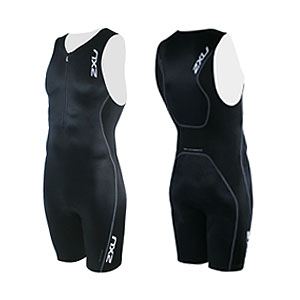
The Elite suit is the standard go-fast short course suit. No pockets. Fast fabric. Concealed zipper. Everything you need. Nothing you don’t. The Elite suit uses 2XU’s signature Hydrocell lycra, which is a silicone-impregnated fabric designed for minimum water absorption and maximum speed in the water, and SBR Skin 2 X-Stretch (Wow, that was a mouthful.), a heavier-gauge fabric that features a silicone coating (as opposed to the fabric being impregnated with silicone). I could make a rather off color joke here, but let’s just say that with impregnated fibers, the silicone is usually coated onto each strand or forced into the fabric, whereas a coating is exactly that, a coating on the final textile. The main panels of the suit are made from said Hydrocell fabric, with an “X” shaped panel on the back that extends under the armpits and down the side of the thighs made of the SBR-many-more-words-go-here skin. This fabric lacks the smooth sheen of the Hydrocell, and is a heavier gauge knit. It feels more like what compression tights would be made out of. It’s actually less stretchy than the Hydrocell, likely because it’s heavier, and I think this is a lot of what gives the suit the supportive cut and feel. 2XU doesn’t break down the fabrics by panel, and the actual percentages of lycra and fabric may be the same, but different yarns, coatings, etc. all make a big difference. If that’s too technical for you, don’t worry, just try it on and see if you give it the “yay” or “nay.” I found that it felt great against the skin, especially when swimming. For biking, it has the typically minimalist fleece pad, which I sort of don’t see the point of. I think short course suits should come without a pad. If you want (or need a pad) you can put a brief on underneath (which I think is more comfy anyway). But if you don’t, you cut down a LOT on weight and water retention, though this pad does a good job of drying quickly. Personally, I think it’s way inferior to the long course pad, which is very unobtrusive and also dries quickly, so I’d either use that pad (or a slimmer version of that pad) everywhere, or I’d go without. But, the fleece pad is sort of status quo for these suits, so I see why they use it. Sometimes people fear change. But you can help them get over that fear when you are a known brand, as 2XU is. The legs are kept in place with a silicone-band on top of an elastic band sewn into the end of the leg.
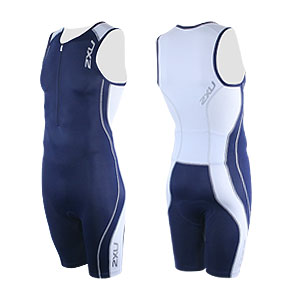
The Competition suit use a mixture of SBR Skin, which differs from the 2 X-Stretch version in that it has no silicone coating and appears to be made of a slightly heavier gauge yarn. It looks, to the casual eye, to be a less tight knit, which ideally would translate into better breathability. The entire front of the suit and the middle panel of the back from the neck down through the center pocket and then down the legs are all made of this fabric. The side pockets up through the armpits are made from the very porous Sensor Mesh fabric, which helps make this suit even more breathable. The long distance chamois is made by a cycling pad maker out of Italy, and it shows as this is one of the nicest pads I’ve seen in a trisuit. It manages to offer a lot of the comfort of a true cycling pad in a very thin and lightweight package that doesn’t get in the way of, uhm, your package during the swim or run. On the bike, it’s a nice change from the fleece pads that most trisuits come with. The leg grippers are the same silicone band as is found on the Elite suit. This suit is extremely comfortable. I think it’s one of the best long-course suits out there, with the pad really setting the suit apart. It’s tight enough to work well underneath a speedsuit for swimming, and of course will be fine under a wetsuit. The cut is tight, but supportive. The lighter, more porous / looser-weave fabric is noticeably more breathable. The cut also features a long back, so that it doesn’t pull in the aero position. This also gives you some more room up top for running. It also has the longest zipper of the bunch and the heaviest gauge zipper, so it is the least snag prone, which means you can expose even more of your manliness to the spectators. The inseam is long, giving full support down the leg. On balance, this is probably the suit that most long course athletes will want to wear from within the 2XU line. Overall, you’d be hard pressed to find a better suit, assuming the cut works for you. It’s also the cheapest suit in the 2XU line, likely due to what seem to be less technical textiles. It’s a lot easier to make a fabric that isn’t designed for wetsuit-less swimming. As with the Elite suit, the legs are held in place by a silicon band on a seamed elastic leg panel.
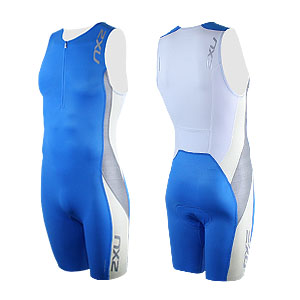
The Super Elite Endurance suit was the real gem of the bunch. It features four different fabrics, in an effort to make this suit the absolute best performing suit for a fast long-course race, where transition times matter. The front panel of the suit is made from the fast swimming Hydrocell fabric. The side panels feature the contoured Rollbar fabric, which is supposedly shaped to help your body roll while swimming, and the dimpled (yes, dimpled) Kinetic Speed fabric which offers (I wasn’t able to confirm or deny) “greater speed through the air and better moisture control.” It is very comfortable, though, so I’ll settle for that. It reminds me of Nike’s Sphere fabric, and I actually found this material to be very nice. The upper back panel is made from the same SBR Skin that the bulk of the regular Competition/Endurance suit is made from. This material is also used to make the single small pocket that sits in the center of the back. The pad is the same very nice long-course pad as is found in the Competition/Endurance suit. The leg grippers on this suit are also unique. The lower legs have no seams at all. The fabric is kept from fraying by “taping” the inside with silicone, which does double duty as the leg gripper to hold the suit in place. This is more comfortable than the silicone bead of the other suits, but it also is a fair bit tighter, exhibiting a noticeable squeeze on my thighs. Yes, I know they are massive and powerful, but I’m just reporting the facts here. This suit was really, really nice to swim in. It felt just like a short course suit, but then I had that nice little pocket if I’d wanted a gel or something and that really heavenly pad for riding the bike. I do think a zipper on the pocket would have been a nice addition for those of us that don’t float so high in the water. It was hard to tell if the pocket was catching any water while I was swimming, but I would have been happier with a zipper because I would have known it was closed, and I also would have known that I wasn’t going to accidentally lose my precious gel or salt or car keys. The Rollbar fabric is certainly very hydrodynamic, but it is also HOT. Riding this suit on the trainer, I had a very sweaty portion of myself right underneath where the Rollbar sat. Given the time of year, I wasn’t able to put it through paces in typical summer race conditions. And in fairness to the suit, I didn’t actually notice how much I was sweating in those spots until I took the suit off. But it definitely merits some more testing under more “real world” conditions. I really liked this suit, but it is clearly geared towards a non-wetsuit swim, which generally means warmer water, which generally comes from warmer air, which means a suit that is hot might be a problem. BUT, that caveat aside, I do think this is one of the best suits I’ve seen for someone who focuses on half-ironman racing. It is fast through transition since you don’t need to peel off a skinsuit. It has a nice, unobtrusive pocket. And the cut is definitely geared towards speed. As with all “fast-swimming” suits, the cut on the trapezius muscles is snug, so make sure you give it some testing on the bike to make sure the tighter cut doesn’t cause you any problems during a longer bike ride. This suit is meant to go fast and assumes that faster is more comfortable. If you are looking for the Ferrari of long-course suits, this is it. A bit less comfortable. Not much storage. But F-A-S-T. The Competition/Endurance suit is more like a Cadillac. All-day comfortable with plenty of trunk space.
Both of the long course suits have upper backs that are made from white fabric (except if you choose the all-black Competition/Endurance suit, which is all black), which is very nice when you consider that you might have that back exposed to the Hawaiian or Arizonian or Lanzarotian sun for a very long time.
All of the suits feature a seamless front panel that covers the entire front of your body with a single seam, except where the suit is sewn together between the legs and where the pad is sewn into the suit. This ultimately makes 2XU’s suits extremely comfortable for swimming and running, since there is much less chafing without seams to rub against you. The downside is a slightly less contoured fit, meaning that people may find the suit to be either too loose or too tight in certain areas, since the fit is more dependent on the fabrics than on the shape of multiple panels. Personally, I think less seams is better, and I found all the 2XU suits to be extremely comfortable, though of a very snug cut. As with all of these reviews, I try not to let how the suit fits ME influence whether or not I think it’s a good suit. It’s much easier to take stock of whether or not the thing balloons up in the water or takes on half the lake when you swim or if it goes all Kriss-Kross on your during the run.
Since we all know triathlon is about exposing your freshly shaven chest to the world, I am happy to report that all the suits I tested featured front zippers, though the short course suits are all available in a back zip version. I actually prefer the back zip, as I think having no seams at all on the chest helps prevent the dreaded nipple chaffage and also looks a lot nicer in race photos. But somehow, everyone seems to have decided on front zippers. I’m hoping the ITU rule for age-group athletes will change this, both for short and long course suits. Back zippers, folks. At least as an option. If you don’t sell any suits, I’ll eat my words happily. But give ‘em a try. For your chest exposers, though, these suits fit the bill. The Competition/Endurance suit had a longer zipper than the other two, and it is also a larger gauge zipper, so it is easier to undo in order to expose your heaving bosom to the world during your marathon. The Elite and Super Elite Endurance suits both feature the concealed zipper, which is a smaller-toothed zipper that disappears in “swim mode.” The Super Elite Endurance suit has a very short zipper, making this suit a bit of a challenge to get into. I mastered it after doing it a few times, but the first two times, I needed help to get into the suit without dislocating my shoulder.
With nice flatlock stitching and overall attention to detail, the 2XU suits get an A in my book. But you need to go to the store to see if they will actually fit you. Pay particular attention to how the suit fits when you first put it on. All the 2XU suits, from a cut perspective, were comfy just standing around. That’s important.
Now onto the critical metrics, weight, water retention, and suit specs:
Dry weight of each suit (all size Medium):
Elite: 172g
Super Elite Endurance: 161g (I find this particularly impressive, because it has a *REAL* pad)
Competition / Endurance: 190g
Weight after 12 minutes agitated wash in cold-water (no detergent):
Elite: 436g
Super Elite Endurance: 371g (who wants a fleece pad again? The nice long course pad smokes the competition even here)
Competition / Endurance: 509g
Weight after spin cycle:
Elite: 224g
Super Elite Endurance: 225g
Competition / Endurance: 238g
The Super Elite really impressed me here. It is designed for long course racing, meaning it has a pocket and a real pad (a great pad, by the way), and it still doesn’t take on much water. It was hot on the trainer, but I’ll do a follow-up once I get this thing out in some 90F sunshine, since there is so much else about the suit that is great. The comp suit does well, though it does hold a lot of water during the initial soak test.
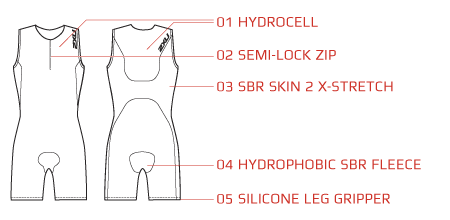
Elite
Price: 150 USD (2007)
Inseam: 22cm (8.66 inches) [All suits feature a very unique set of panels around the crotch, presumably to eliminate seams under your stuff, which is nice, but it makes them hard to measure. I measured bottom to bottom and divided by 2 for all suits.]
Width at the top of the shoulder: 6.5cm (2.36 inches)
Pad: Yes – fleece.
Stitching: 100% flatlock stitching
Zipper: Front-zip. Opens 26cm (10.24 inches) inches.
Materials: Hydrocell & SBR Skin 2 X-Stretch
Pockets: None
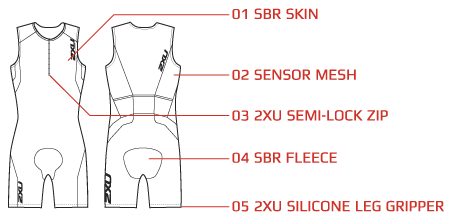
Competition / Endurance
Price: 95 USD (2007)
Inseam: 22cm (8.66 inches)
Width at the top of the shoulder: 8.5cm (3.35 inches)
Pad: Yes – 2XU custom-made long-course pad.
Stitching: 100% flatlock stitching
Zipper: Front-zip. Opens 29cm (11.41 inches) inches.
Materials: SBR Skin & Sensor Mesh
Pockets: Three – lumbar spine, and equal sized pockets located immediately left and right of that.
Super Elite Endurance
Price: 275 USD (2008)
Inseam: 22cm (8.66 inches)
Width at the top of the shoulder: 8cm (3.14 inches)
Pad: Yes – 2XU custom-made long-course pad.
Stitching: 100% flatlock stitching
Zipper: Front-zip. Opens 22cm (8.66 inches) inches.
Materials: Hydrocell, Rollbar, Kinetic Speed, and SBR Skin.
Pockets: One – center back over lumbar spine.
For more on 2XU and to see their complete line-up (including the 2008 products), visit 2XU.com.


